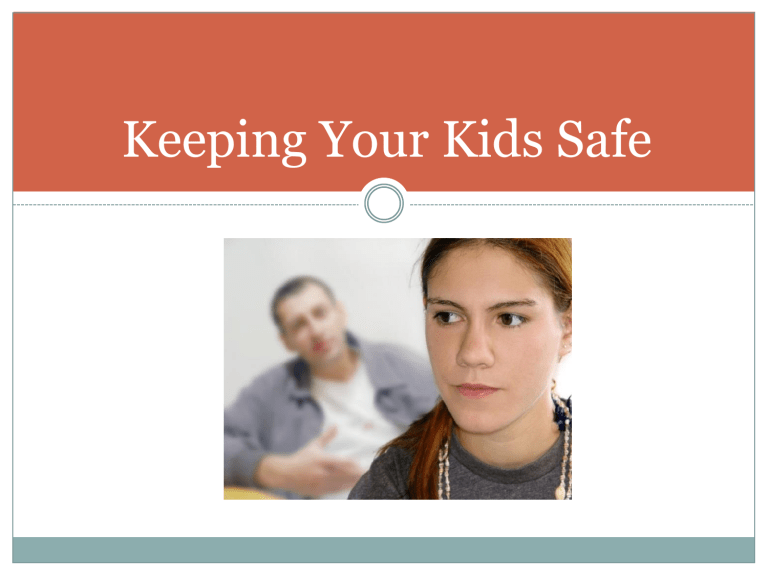Keeping Your Kids Safe_Updated 2

Keeping Your Kids Safe
Kid and Youth Safety
There are many aspects of safety. What we are going to briefly discuss today is:
Sexual exploitation
Self/Peer exploitation
Consent
Age appropriate ways to discuss these issues
Brief introduction to online and phone safety
About the Taskforce
Initiated in 1998
Sub-committee of Public Safety Committee
Chaired by Burnaby City Councillor Colleen Jordan
Co-Chair Burnaby School Board Trustee Baljinder Narang
Other membership: RCMP, New West Police, Non-Profits
(e.g. St. Leonard’s, Odyssey), MCFD, Fraser Health etc.
Two primary goals over the years:
Ensure adequate support, services and treatment for sexually exploited youth
Prevent the sexual exploitation of children and youth
What is Sexual exploitation?
Sexual exploitation is the sexual abuse of children and youth through the exchange of sex or sexual acts for food, shelter, a ride, drugs/alcohol, or money.
What is Self/Peer Exploitation?
Youth creating, sending or sharing sexual images and/or videos with peers via the Internet and/or electronic devices.
It usually involves exchanging images/videos through cell phone picture/video messaging, messaging apps
(on iPhones, Blackberries, Androids), social networking sites, etc.
The Criminal Code
It is a criminal offence to:
buy sexual service from someone under 18 procure or attempt to procure a person for the purposes of selling sex (i.e.. pimping) live on money made from selling sex
keep or live in a place that exists for the purposes of buying & selling sex communicate in public to buy or sell sex
Send or receive nude photos or sexual images/videos of individuals who are under the age of 18
Any electronic communication between and adult and a child this is, or could be perceived as, sexual in nature may be illegal
(luring).
Consent in Canada
A child under 12 can NEVER consent to sexual activity.
The age of consent for sexual activity is 16.
There exist two close-in-age exemptions, depending on the age of the younger partner.
A youth of twelve or thirteen can consent to sexual activity with an individual no more than two years older than them.
A fourteen- or fifteen-year-old can consent to sexual activity with a partner who is no more than five years older than them.
Consent in Canada
Consent rises to 18 years old when the older person is in a position of trust or authority or when the relationship is exploitative in nature or when the young person is dependent on the older person for some reason.
The onus is on the older partner to ensure the age of their partner.
What makes youth vulnerable?
Developmental Age (risk taking)
Low self esteem
History of abuse or trauma
Lack of security and sense of belonging
Drug and alcohol abuse
Other reasons cited by youth
Family members in the sex trade
Desire for adventure, independence; “easy” money
Influence of friends and peers
Image of prostitute as glorified outlaw or glamorous figure
POTENTIAL Warning signs
Withdrawing from home life
Seems to be more sad, anxious, defensive, angry or secretive
Being extremely protective about new boyfriend/girlfriend
Having a new and much older boyfriend/girlfriend
Suddenly dropping old friends for new group
Repeatedly coming home drunk or on drugs
Unexplained changes in behavior, routine, appearance, language
Loss of interest in activities they normally have enjoyed
Violating curfew
Having unexplained money, clothing and trinkets
Displaying unexplained bruises on body
Complaints of stomach aches or headaches
Differences in sleep patterns
Age Appropriate Discussion Methods
Elementary Aged:
Learn proper terms for body parts
Discuss ‘body boundaries’
Older grades: start discussing healthy relationship behaviors
Start a conversation about how to use technology and what limits you expect
No technology in the bedroom
Secondary Aged:
Continue talking about healthy relationships
Discuss sexting and its implications
Continue discussion about technology use, stay up-to-date on programs and aps
No technology in the bedroom
Smartphone Safety
Prevention & Early Intervention Toolkit for Parents
www.childrenofthestreet.com
What you can do
Read through the “Keeping Teens Safe from Online
Sexual Exploitation” and “Smartphone Safety” pamphlets
Watch the parent video series at www.childrenofthestreet.com/
Have an ongoing conversation with your child(ren)
Educate others at your school
Visit http://mediasmarts.ca
for tips about talking to your kids about sexting and online safety
What you can do
Talk to the Administrators, Counsellors and Safe
School Specialists at your child’s school
Be aware of and use community resources including the Taskforce’s website: www.WTF411.ca
, St.
Leonard’s Society, Purpose Society and Children of the Street
Go to https://www.cybertip.ca/app/en/ to make a report
Small Group Discussion
Break into small groups based on age of child(ren) and discuss questions on next slide
Primary
Intermediate
Secondary
Questions for Small Group Discussion
What are the differences that you see (for your child’s age group) between healthy exploration vs. risky behavior vs. exploitation?
When are best times/places to talk to you child about this topic?
What are some of the ways kids can be recruited through peers?
What are some conversation starters you can use to discuss these topics?
Thank you!!!
QUESTIONS?
For more information please email taskforcebnw@gmail.com


